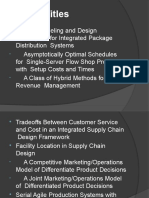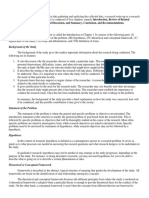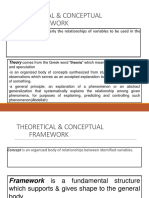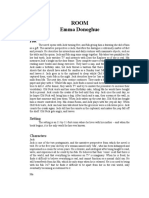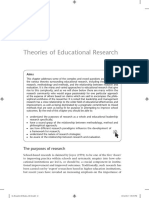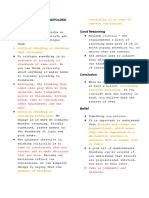100%(1)100% found this document useful (1 vote)
14K viewsParts of Chapter 1
This document outlines the typical sections included in the introductory chapter of a research study, including: the introduction, background of the study, statement of the problem, theoretical framework, conceptual framework, assumptions and hypothesis, scope and delimitations, limitations of the study, definition of terms, and significance of the study. Each section is briefly described in 1-2 sentences. The introduction orients the reader to the topic and purpose of the research. The background provides context around what led to the problem. The statement of the problem clearly defines the research questions. The theoretical and conceptual frameworks establish the foundations and perspective for the study.
Uploaded by
shaira alliah de castroCopyright
© © All Rights Reserved
Available Formats
Download as PDF, TXT or read online on Scribd
100%(1)100% found this document useful (1 vote)
14K viewsParts of Chapter 1
This document outlines the typical sections included in the introductory chapter of a research study, including: the introduction, background of the study, statement of the problem, theoretical framework, conceptual framework, assumptions and hypothesis, scope and delimitations, limitations of the study, definition of terms, and significance of the study. Each section is briefly described in 1-2 sentences. The introduction orients the reader to the topic and purpose of the research. The background provides context around what led to the problem. The statement of the problem clearly defines the research questions. The theoretical and conceptual frameworks establish the foundations and perspective for the study.
Uploaded by
shaira alliah de castroCopyright
© © All Rights Reserved
Available Formats
Download as PDF, TXT or read online on Scribd
You are on page 1/ 39
Parts of Chapter 1
Introduction Assumptions and
Background of the Hypothesis
Study Scope and
Statement of the Delimitations of the
Problem Study
Theoretical Limitations of the
Framework Study
Conceptual Definition of Terms
Framework
Introduction
Discusses four (4) relevant ideas:
TOPIC or subject matter: define and elaborate
using methods of paragraph development like
classification and giving examples
IMPORTANCE of the Topic: cite the role that the
topic plays in your life and the benefits you
derive from it.
REASONS for Choosing the topic: emphasized
what motivated you to choose the topic.
PURPOSE of the Study: discusses the objective
of the study.
Background of The Study
consists of statements on what led the
investigator to launch the study.
may have been generated by some
empirical observations, the need to
explore the problem and some other
relevant conditions.
describe as clearly as possible the
problem intended to be addressed and
refer to the relevant literature in the field.
Background of the Study
it is an overview of factors which have
led to the problem, comprise the
problem and historical significance
relative to the problem.
Statement of the Problem
There should be a general statement of
the whole problem followed by the
specific questions or sub problems into
which the general problem is broken up.
Theoretical Framework
This is the foundation of the research
study. These are highly related theories
and principles that were established and
proven by authorities
refers to the set of interrelated construct,
definitions, and prepositions that
presents a systematic view of
phenomena
Theoretical Framework
an organized body that explains what
has been done and what has been said
on the topic or problem being
investigated.
What must be obtained from a
theory?
The name/s of author/s of the theory
must be taken including the place and
the time / year when he or she
postulated such a principle or
generalization.
the part or parts of the theory that are
relevant to your study
synthesis by relating to your findings
Conceptual Framework
a tentative explanation or theoretical
explanation of the phenomenon or
problem and serves as the basis for the
formulation research hypotheses.
consists of the investigator’s own
position on a problem after his exposure
to various theories that have bearing on
the problem
Conceptual Framework
The conceptual framework becomes the
central theme, the focus, the main thrust
of the study. It serves as a guide in
conducting investigation.
Paradigm. A paradigm is a
diagrammatic representation of a
conceptual framework. It depicts in a
more vivid way what the conceptual
framework wants to convey.
Conceptual Framework:
Paradigm
Deductive Reasoning
: In deductive reasoning, a conclusion is
reached reductively by applying general
rules that hold over the entirety of
a closed domain of discourse, narrowing
the range under consideration until only
the conclusion is left.
a method of reasoning by which
concrete applications or consequences
are deducted from general principles or
theorems
Assumptions and
Hypothesis
Historical and descriptive investigations
do not need explicit hypotheses and
assumptions. Only experimental studies
need expressly written assumptions and
hypotheses.
Assumptions- a belief that forms one
of the bases for the research. This belief
is not to be tested or supported with
empirical data. Very often belief is not
stated in a research proposal.
Assumptions and
Hypothesis
Hypothesis is a tentative answer to a
research question, it can be derived
from the observation before the research is
conducted. This is called inductive
hypothesis.
from the theory. This is called deductive
hypothesis.
Kinds of Hypothesis
Research hypothesis is usually
developed from experience, literature or
theory, or combination of these. This is
the expected relationship
between variables.
Null hypothesis is the one that states
NO relationship between varibales. The
function is to let the research test the
hypothesis statistically.
Scope and Delimitations
The scope and delimitations should
include the following:
A brief statement of the general purpose of
the study.
The subject matter and topics studied and
discussed.
The locale of the study, where the data were
gathered or the entity to which the data
belong.
Scope and Delimitations
The population or universe from which the
respondents were selected. This must be
large enough to make generalizations
significant.
The period of the study. This is the time,
either months or years, during which the
data were gathered.
Limitations of the Study
include the weaknesses of the study
beyond the control of the researcher.
The weaknesses spring out of the
inaccuracies of the perceptions of the
respondents.
Variables
is the operationalized way in which the
attribute is represented for further data
processing.
Values of each variable statistically
"vary" (or are distributed) across the
variable's domain
Basically, a variable is any factor that
can be controlled, changed, or
measured in an experiment.
Types of Variables
The independent variable is the one
condition that you change in an
experiment.
The dependent variable is the variable
that you measure or observe. It is the
factor that is dependent on the state of
the independent variable.
Types of Variables
A controlled variable or constant
variable is a variable that does not
change during an experiment.
Extraneous variables are "extra"
variables that may influence the
outcome of an experiment, but aren't
taken into account during measurement.
Significance of the Study
The rationale, timeliness and/or
relevance of the study. The rationale,
timeliness and/or relevance of the study
to existing conditions must be explained
or discussed.
Possible solutions to existing problems
or improvement to unsatisfactory
conditions.
Significance of the Study
Who are to be benefited and how they
are going to be benefited. It must be
shown who are the individuals, groups,
or communities who may be placed in a
more advantageous position on account
of the study.
Possible contribution to the fund of
knowledge.
Significance of the Study
Possible implications. It should be
discussed here that the implications
include the possible causes of the
problems discovered, the possible
effects of the problems, and the
remedial measures to solve the
problems.
Definition of Terms
Only terms, words, or phrases which
have special or unique meanings in the
study are defined.
Terms should be defined operationally,
that is how they are used in the study.
The researcher may develop his own
definition from the characteristics of the
term defined.
Definition of Terms
Definitions may be taken from
encyclopedias, books, magazines and
newspaper articles, dictionaries, and
other publications but the researcher
must acknowledge his sources.
Definitions should a\be brief, clear, and
unequivocal as possible.
Acronyms should always be spelled out
fully
You might also like
- How To Write Chapter 1 of A Research: Basic Format73% (15)How To Write Chapter 1 of A Research: Basic Format3 pages
- Introduction and Background of The StudyNo ratings yetIntroduction and Background of The Study22 pages
- Coghlan, D. (Annals, 2011) - Action Research Exploring Perspectives On A Philosophy of Practical Knowing100% (1)Coghlan, D. (Annals, 2011) - Action Research Exploring Perspectives On A Philosophy of Practical Knowing36 pages
- Chapter 2 Review of Related Literature and Studies100% (3)Chapter 2 Review of Related Literature and Studies15 pages
- Chapter 1: The Problem and Its BackgroundNo ratings yetChapter 1: The Problem and Its Background9 pages
- Writing The Introduction: Agric. 206 (Methods of Agricultural Research)No ratings yetWriting The Introduction: Agric. 206 (Methods of Agricultural Research)10 pages
- Research Capstone Project PPT AY 2020 2021No ratings yetResearch Capstone Project PPT AY 2020 202111 pages
- Conceptual Framework - Scope and Delimitation of The StudyNo ratings yetConceptual Framework - Scope and Delimitation of The Study3 pages
- Introduction and Background of The StudyNo ratings yetIntroduction and Background of The Study46 pages
- 2nd Quarterly Examination On Practical Research 2No ratings yet2nd Quarterly Examination On Practical Research 25 pages
- Lecture On Theoretical Conceptual FrameworksNo ratings yetLecture On Theoretical Conceptual Frameworks22 pages
- Cursive Handwriting Skills: October 2018No ratings yetCursive Handwriting Skills: October 201818 pages
- Science, Technology, and Society and The Human ConditionNo ratings yetScience, Technology, and Society and The Human Condition6 pages
- Question Text: Integrated Marketing Communications Involves Coordinating Only Paid Personal CommunicationsNo ratings yetQuestion Text: Integrated Marketing Communications Involves Coordinating Only Paid Personal Communications18 pages
- Language Functions and Forms: A Brief SummaryNo ratings yetLanguage Functions and Forms: A Brief Summary2 pages
- Instructions in The Early Generations vs. Instructions in The 21st Century100% (1)Instructions in The Early Generations vs. Instructions in The 21st Century15 pages
- Davies About Grice's Cooperative Principle PDFNo ratings yetDavies About Grice's Cooperative Principle PDF26 pages
- Expert System Chapter 3: Knowledge RepresentationNo ratings yetExpert System Chapter 3: Knowledge Representation41 pages
- The Idea of Language Giorgio Agamben Caner C3a7etiner 12-11-20151No ratings yetThe Idea of Language Giorgio Agamben Caner C3a7etiner 12-11-2015128 pages
- Christopher Simpson - Divine Hyperbolics - Desmond, Religion, Metaphysics, and The PostmodernNo ratings yetChristopher Simpson - Divine Hyperbolics - Desmond, Religion, Metaphysics, and The Postmodern286 pages
- Disciplines and Ideas in The Social Sciences: Quarter 1 - Week 1 Grade 11 HumssNo ratings yetDisciplines and Ideas in The Social Sciences: Quarter 1 - Week 1 Grade 11 Humss4 pages
- Leobelo Jofel Delicana June 24, 2013 AB Philosophy IV EpistemologyNo ratings yetLeobelo Jofel Delicana June 24, 2013 AB Philosophy IV Epistemology2 pages
- Beyond Pure Reason: Ferdinand de Saussure's Philosophy of Language and Its Early Romantic AntecedentsNo ratings yetBeyond Pure Reason: Ferdinand de Saussure's Philosophy of Language and Its Early Romantic Antecedents12 pages
- How To Write Chapter 1 of A Research: Basic FormatHow To Write Chapter 1 of A Research: Basic Format
- Coghlan, D. (Annals, 2011) - Action Research Exploring Perspectives On A Philosophy of Practical KnowingCoghlan, D. (Annals, 2011) - Action Research Exploring Perspectives On A Philosophy of Practical Knowing
- Chapter 2 Review of Related Literature and StudiesChapter 2 Review of Related Literature and Studies
- Writing The Introduction: Agric. 206 (Methods of Agricultural Research)Writing The Introduction: Agric. 206 (Methods of Agricultural Research)
- Conceptual Framework - Scope and Delimitation of The StudyConceptual Framework - Scope and Delimitation of The Study
- Science, Technology, and Society and The Human ConditionScience, Technology, and Society and The Human Condition
- Question Text: Integrated Marketing Communications Involves Coordinating Only Paid Personal CommunicationsQuestion Text: Integrated Marketing Communications Involves Coordinating Only Paid Personal Communications
- Instructions in The Early Generations vs. Instructions in The 21st CenturyInstructions in The Early Generations vs. Instructions in The 21st Century
- The Idea of Language Giorgio Agamben Caner C3a7etiner 12-11-20151The Idea of Language Giorgio Agamben Caner C3a7etiner 12-11-20151
- Christopher Simpson - Divine Hyperbolics - Desmond, Religion, Metaphysics, and The PostmodernChristopher Simpson - Divine Hyperbolics - Desmond, Religion, Metaphysics, and The Postmodern
- Disciplines and Ideas in The Social Sciences: Quarter 1 - Week 1 Grade 11 HumssDisciplines and Ideas in The Social Sciences: Quarter 1 - Week 1 Grade 11 Humss
- Leobelo Jofel Delicana June 24, 2013 AB Philosophy IV EpistemologyLeobelo Jofel Delicana June 24, 2013 AB Philosophy IV Epistemology
- Beyond Pure Reason: Ferdinand de Saussure's Philosophy of Language and Its Early Romantic AntecedentsBeyond Pure Reason: Ferdinand de Saussure's Philosophy of Language and Its Early Romantic Antecedents





























